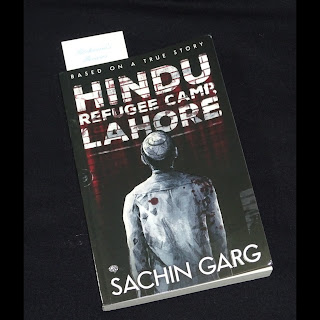Author: Sachin Garg
Publisher: Grapevine India
What would you do if you were stuck on the
other side of the border, with neither country accepting you as their own?
Hindu Refugee Camp, Lahore by Sachin Garg is written as an
exchange of letters that narrates the true story of Havildar Ghulam Ali Limb-Fitter.
Set in the events post-independence, in 1958, it rests on the fact that while
the partition of India happened in 1947, its impact has continued to be felt on
people on both sides of the border. The thing that Ghulam Ali desperately wants
is to be able to go to his motherland, to Lucknow where the love of his life
Zahira waits for him. His life takes a turn when he finds himself in a Hindu
Refugee Camp, Lahore. Beaten up, injured and starving, he is at his lowest, but
finds the will to try everything in his power to come back. Zahira had a dream
to dance to her heart’s content, but there is one hiccup, the solution to which
lies with Ghulam Ali. Living with her nani and her sister, she battles the
challenge of being a working Muslim Woman in the 1950s. Would Ghulam Ali be
able to return to his homeland and be reunited with his love, or are they
destined to be separated by the line that divided the country?
The story is a very powerful telling of the impacts that the partition of India had on the people living in the erstwhile India. Through Ghulam Ali, the author manages to convey the pain that the people felt on both sides of the border and how religion was used as a tool to push people into doing something they wouldn’t usually do. Using letters, the condition of both the countries is told, as Ghulam narrates the events from Lahore and Zahira presents the events from the Indian side. The letters are very emotive and using a mix of Hindi, English and Urdu, the author manages to maintain the authenticity of the story. The descriptions of scenes are extremely vivid, and it helps the imagination of the reader. Another thing that stands out is the way the letters are structured and how, while narrating the present, he sets the foundation by telling the stories of the past. The end of the story was something I would not have expected in the way it happens. While fearing for the worst, I loved the way Sachin used the moment to plunge the reader into the depths of despair and then pulling them up sharply. That, for me, was the poetic way to end the story of Ghulam Ali.
Based on true events, Sachin has created
wonderful characters in Ghulam Ali and Zahira Raza. Their character arcs are
beautifully sketched, and the climax adds a shine to the buildup through the
letters. Another striking aspect is that Sachin uses his secondary characters
to enforce the idea that no matter what the situation, people have a tendency
to look at optics and through various characters such as Pundit Ji, he manages
to do that in an excellent manner. I loved the way Zahira’s character unfolds
in the end, and I was truly impressed by the revelations in the last chapter.
Overall, a book worth reading, not just for
the story and the plot, but to understand the emotions that people felt, and
still feel post the events that night in 1947.
The book gets a 4.76/5 from me.
Get a copy of the book here.




Well-written!
ReplyDelete